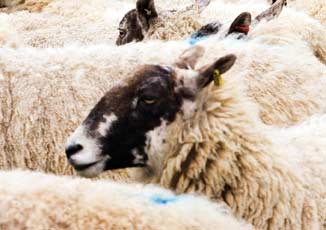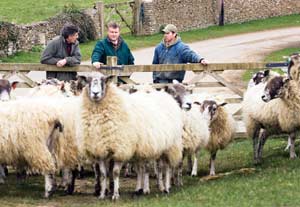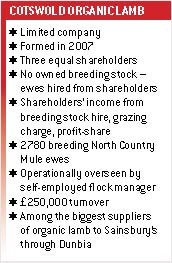Profitable Lowland sheep enterprise

Can a lowland sheep flock really deliver returns as a stand-alone enterprise? Ian Ashbridge looks at how a college flock has become part of an innovative new business The strangest thing about Cotswold Organic Lamb – now one of the biggest suppliers of organic lamb to Sainsbury’s and turning over £250,000 a year – is that it doesn’t own any ewes. A serious problem for a commercial lamb production business, one would think. But if you’re looking for a radical way to reduce fixed costs, it’s a simple but effective solution. Instead, the three shareholding businesses behind Cotswold Organic Lamb hire breeding stock to the new enterprise – which pays them a fee – and lambs are finished across 2000 acres of rolling Cotswold grassland, for which the shareholders receive a grass-keep payment. In addition, each of the parent businesses’ shareholding in Cotswold Organic Lamb is equal, and each receives a one-third share dividend in any profits. But none of this happened by chance. Three years ago, falling returns from the Royal Agricultural College’s in-hand sheep flock meant a fresh approach was needed.
“We consistently outperformed the top 5% of lowland flocks in benchmarked gross margin analysis, but our overhead costs were too high with in-hand labour and rented land and buildings,” says RAC farms director David Hardy.

Setting up Cotswold Organic Lamb allowed RAC farms director David Hardy and Charles Hunter Smart (left) to cut overhead costs. They are pictured with Paul Webster (right).
“In the absence of sheep annual premium, we had to ask ourselves: Does this really stack up now? Lowland sheep just weren’t able to profit in that environment and it’s just not logical to use the single farm payment to prop it up, if it’s meant to be divorced from the requirement to produce.”
The college flock of 1650 breeding ewes on two sites was integrated within a conventional arable system including permanent grass and short-term leys. North Country Mule ewes with Suffolk, Texel, Meatlinc and Hampshire tups helped a high-performance flock achieve 180% lambs sold – consistent for 10 years. The operation was run with the college farms’ own staff on rented land over two sites. Seen as a stand-alone entity, the RAC sheep flock was just weighed down with overhead costs.
It wasn’t an immediate transition. “We were already trying hard to cut overheads by lambing a proportion of the flock outdoors to save on labour, and we’d marginally increased ewe numbers to spread costs,” says Mr Hardy.
At the heart of the Cotswold Organic Lamb project is a series of opportunities, carefully identified and pursued. “We knew a lot of organic-conversion land was available locally, which was under-utilised. It needs to have livestock on it to build fertility and itÕs not free, but itÕs a lot cheaper than renting land and re-seeding it every two years.”
But it wasn’t just a matter of convenience. “At the time, the other driver was the availability of a significant premium for organic lamb. Our market intelligence was pretty rigorous. We talked to a number of abattoirs and studied market reports in depth Ð it was clear at that stage that consumers genuinely were becoming more discerning in the choices they were making.
“We also saw organic conversion, and the premium it offered, as a way of adding value to all the lambs sold, rather than developing a niche for a few. If we”d managed to sell a few through local pubs and restaurants, we might well have received some kind of premium on 50 – but what about the other 2950?
 “It’s true that some of that organic premium has fallen away, but we couldn’t have predicted the arrival of the credit crisis and the recession – and even without an organic premium, prime lamb prices have now moved up to fill the gap,” says Mr Hardy.
“It’s true that some of that organic premium has fallen away, but we couldn’t have predicted the arrival of the credit crisis and the recession – and even without an organic premium, prime lamb prices have now moved up to fill the gap,” says Mr Hardy.
Involvement with a local farm discussion group – Cotswold Organic Growers – led to the three eventual shareholders coming together. “We were already grazing land for DJ & SJ Phillips at Fairford in Oxfordshire and began at Bradwell Grove Farms near Burford in 2006,” says Mr Hardy.
During 2006, the idea for the Cotswold Organic Lamb project began to take shape. “We had several meetings to discuss how to best use everyone’s available grassland within an organic rotation most effectively. And we saw some merit in an extensive lowland sheep enterprise that ranched all the land it managed together.”
The belt of land made available by the three shareholders is far from ring-fenced, but continuous enough to make managing a flock possible. “We found we had access to quite a swathe of suitable land – roughly 2000 acres,” says Mr Hardy.
“The business was never intended to own the ewes that it used. The breeding stock of 1650 ewes remained the property of the RAC and the flock was expanded by shareholders funding an additional 200 ewes each.” More shearlings were added and the flock now stands at 2780 breeding ewes. Lambing is outdoors, in April, and lambs are finished almost entirely on grazing alone.
“The new business pays a hire charge for the ewes it uses and a fee for the land they graze on Ð we strike a grazing charge based on the market rate in the locality, both on shareholders’ land and for others,” says Mr Hardy.
The breeding hire fee that the shareholders receive is based on: The purchase price of the ewe, a depreciation charge on the value of each ewe, how long they last in the flock, the value of buying in replacement shearlings and the value of cull animals. Interest is also paid on the purchase of the ewes at 6.5% giving a return on capital of about 5% a ewe each year.
“We pay this back to shareholders 12 months in arrears, and the calculation is revisited each year,” says Mr Hardy. “At the time of the initial calculation it worked out at about £19.25 a ewe.”
The grazing charge varies between 15p and 25p a head a week, with no distinction made between ewes and lambs.
The punitive cost of employing a full-time member of staff was avoided by hiring in contract services. The flock is run by self-employed flock manager Peter Webster, who brings his own dogs, quad-bike and vehicle.
“It’s run as one flock,” says Mr Webster. “We try and keep things as simple as possible. Spring 2009 is the first time we’ve lambed on all three sites, which has proved a challenge.”
Now in its third year, the business has passed its break-even point and is looking for new ways to grow. “We’re keen to explore the possibility of developing the Cotswold Organic Lamb brand,” says Mr Hardy. “But for now, we’re proud to have created a stand-alone, transparent, ring-fenced lowland sheep business that has no stewardship or single payment money to blur the bottom line and still delivers a significant return.”
